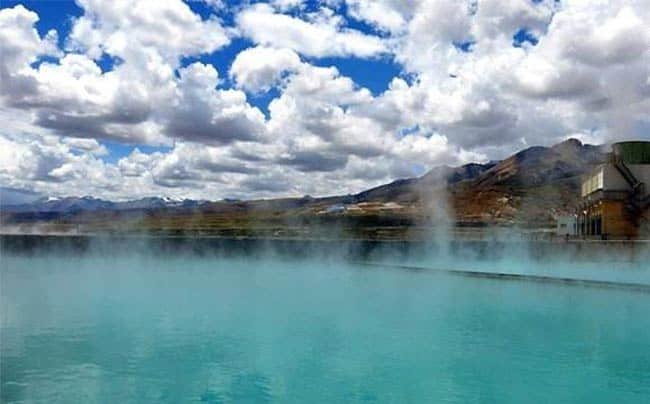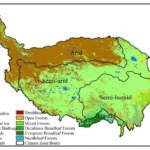Introduction to Hot Springs in Central Tibet
Hot springs, a remarkable geothermal phenomenon, have long fascinated visitors and locals in Central Tibet. These natural wonders arise from the Earth’s crust, giving rise to mineral-rich waters that are heated by the planet’s geothermal activity. Central Tibet is home to numerous hot springs, each showcasing its unique characteristics and aesthetic beauty. Nestled among the stunning landscapes of the Tibetan plateau, these geothermal pools offer not only breathtaking views but also serve as vital resources for the communities that surround them.
The importance of hot springs in Central Tibet extends beyond their captivating appearance. They occupy a significant place in Tibetan culture and spirituality. Many of these springs are deemed sacred by local populations, often associated with healing properties. The mineral waters are believed to cure various ailments, leading to their historical use in traditional medicine practices. As such, these locations are frequented by both locals seeking therapeutic benefits and pilgrims hoping to gain spiritual enlightenment. In this sense, hot springs function as dual-purpose sites, fostering both physical rejuvenation and spiritual healing.
Visitors to Central Tibet are often drawn to these geothermal treasures, where the serene ambiance allows for relaxation and reflection amidst the tranquil landscape. The soothing warmth of the springs provides a stark contrast to the often harsh climatic conditions found in the region. Various hot springs, such as the renowned Tsojang Spring and the lesser-known Yangpachen hot springs, are easily accessible and provide opportunities for both leisure and cultural interactions. The allure of these sites manifests not only in their natural beauty but also in their revitalizing powers, making them a focal point for exploration. As we delve deeper into the hot springs of Central Tibet, a richer understanding of their significance and experiences awaits.
Notable Hot Springs in Central Tibet
Central Tibet is home to a myriad of hot springs that attract both visitors and locals alike, each offering unique experiences and remarkable therapeutic benefits. Among the most renowned is the Yangpachen Hot Springs, located approximately 80 kilometers north of Lhasa. This geothermal marvel is known for its high mineral content, which is reputed to aid in the treatment of various skin conditions and rheumatic ailments. The facility here features several pools and even a steam room, enhancing the overall wellness experience amidst stunning mountainous backgrounds.
Another significant site is the Dezong Hot Springs, nestled in the vicinity of the Dezong Monastery. These springs have historical relevance, as they have been used by sages for centuries. The water is rich in sulfur and other minerals, making it an excellent option for rejuvenation and relaxation. Visitors can enjoy soaking in the warm waters while taking in the serenity of the surrounding landscape, which plays a vital role in the therapeutic experience.
Close to the famed Yarlung Tsangpo River, the Xiqian Hot Springs offer a more remote bathing experience. The location is relatively less commercialized, providing a tranquil atmosphere for those seeking solitude and peace. The healing properties of these springs have been celebrated in local folklore, emphasizing their significance in Tibetan culture.
The Tirthapuri Hot Springs, located near the sacred Mount Kailash, are often visited by pilgrims seeking spiritual and physical healing. The springs are reputed not only for their mineral-rich waters but also for the scenic views they provide, reflecting the grandeur of the surrounding Tibetan plateau.
Lastly, the Chiu Hot Springs are well-known for their therapeutic effects and are situated within the ancient Chiu Monastery. The site combines spiritual importance with wellness, attracting both tourists and devotees alike. The surrounding area is characterized by awe-inspiring landscapes, making it a perfect spot for relaxation and contemplation.
Cultural and Healing Importance of Tibetan Hot Springs
Tibetan hot springs hold profound significance within the cultural and spiritual landscape of Central Tibet. These natural geothermal wonders are regarded not only for their therapeutic properties but also for their deep-rooted connections to Tibetan belief systems. Many locals and visitors attribute a range of healing benefits to the mineral-rich waters, often declaring that immersion can cure ailments and rejuvenate the spirit. This belief permeates local traditions and practices, intertwining nature with the spiritual core of Tibetan culture.
Throughout history, Tibetan hot springs have served as vital stops along pilgrimage routes leading to sacred sites. Pilgrims journey to these springs, believing that a soak in the warm waters enhances their spiritual journey. This practice is intertwined with the wider Tibetan understanding of health, which encompasses both physical and spiritual dimensions. The experience of soaking in these springs is often viewed as a means to cleanse oneself, purify the mind, and connect with the surrounding environment, thus promoting both overall wellbeing and spiritual enrichment.
The hot springs are also seen as sacred spaces, where locals engage in rituals and ceremonies. Such practices might include offerings to deities or performing traditional prayers. The waters are viewed as gifts from the earth, nurtured by the energy of the region’s mountains and landscapes. Consequently, these springs contribute significantly to the local economy by attracting visitors seeking healing, relaxation, or spiritual renewal. Community festivals often feature these sites, wherein share cultural stories and collective spiritual experiences further reinforce their importance.
Through the intermingling of natural beauty, cultural reverence, and spiritual significance, Tibetan hot springs symbolize a unique aspect of Tibet’s heritage. Their enduring legacy showcases the vibrant relationship between the Tibetan people and their environment, highlighting a commitment to holistic health and spiritual welfare.
Conclusion: The Fusion of Nature and Spirituality
The hot springs of Central Tibet stand as profound symbols of the intricate relationship between nature and spirituality. Renowned for their therapeutic properties, these natural wonders provide sanctuaries for those seeking both physical healing and spiritual rejuvenation. The healing waters, enriched with minerals, have been revered for centuries, attracting pilgrims, travelers, and wellness enthusiasts alike. Visitors flock to these geothermal marvels not only for their restorative qualities but also for the tranquil experience they offer amidst the stunning backdrop of the Tibetan plateau.
This unique blend of the natural and the spiritual is deeply embedded in Tibetan culture. The hot springs are often associated with local legends and religious practices, further enhancing their significance. Each site carries its own stories, making these springs not just locations for relaxation but also places of contemplation and reflection. The serene environment, coupled with the rich cultural tapestry of the region, invites visitors to connect with both the landscape and their inner selves, leading to profound experiences that resonate long after one’s visit.


